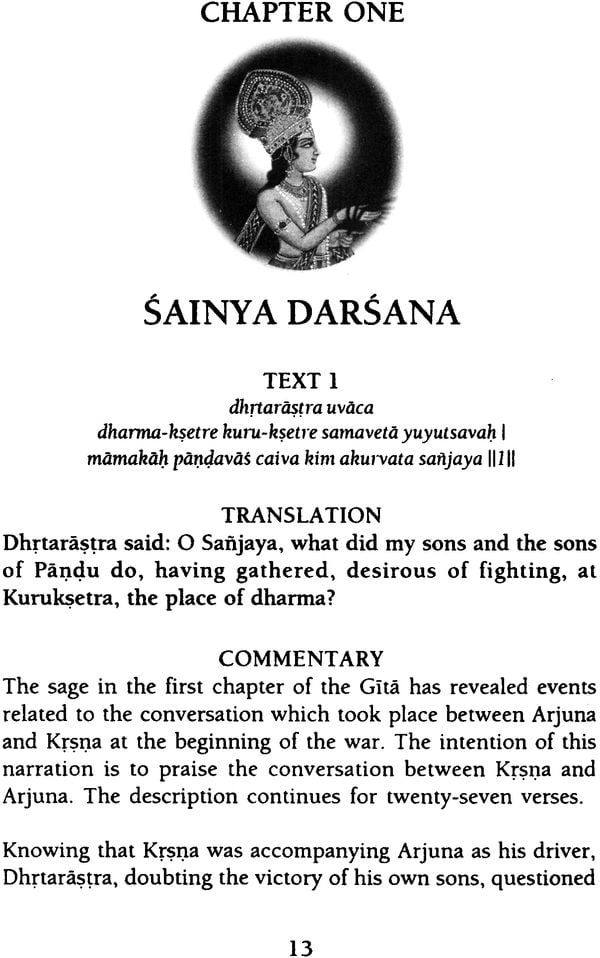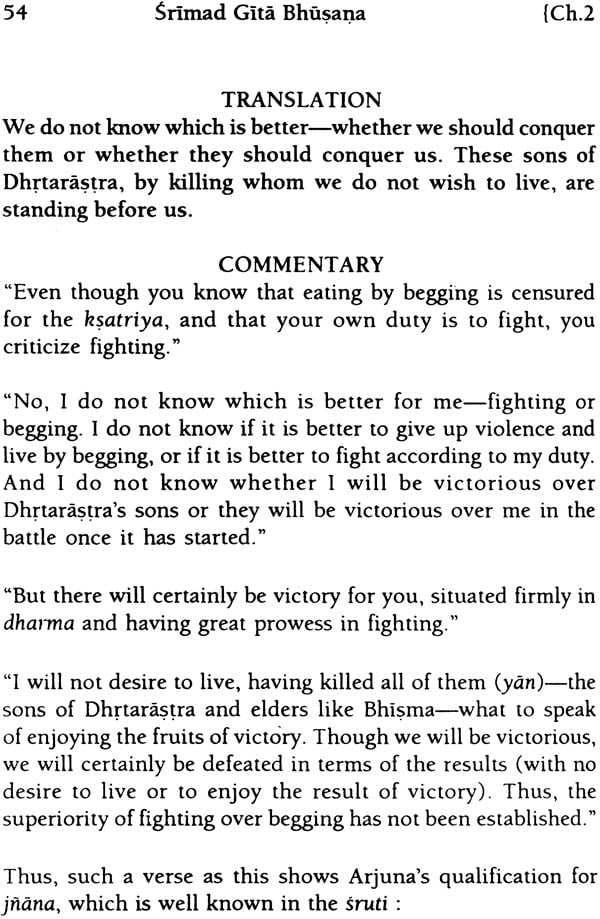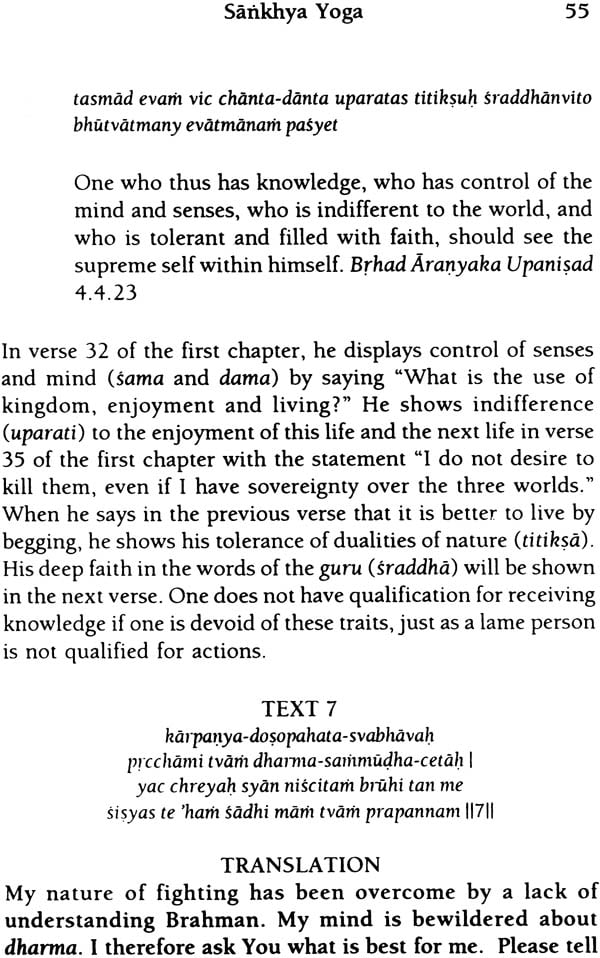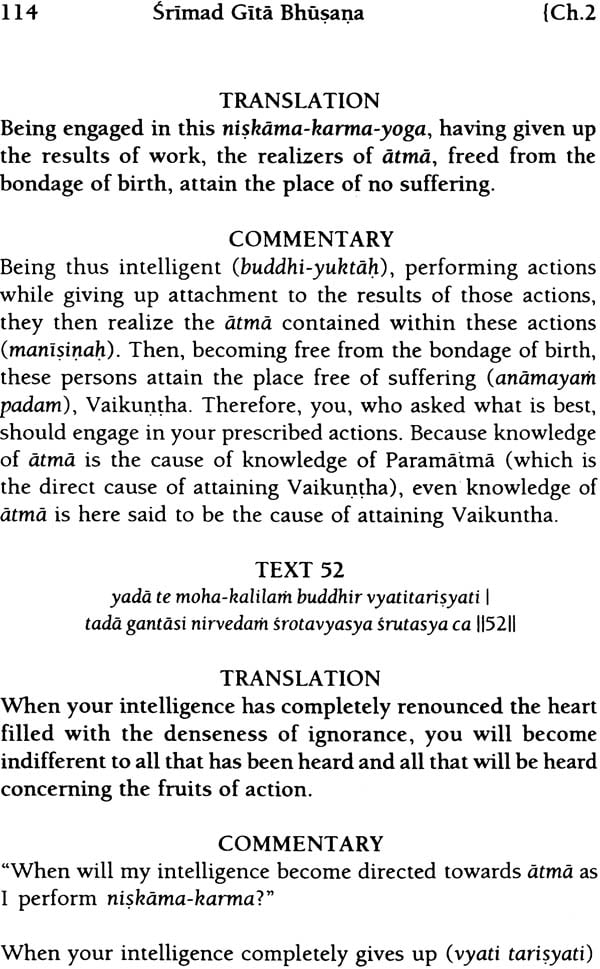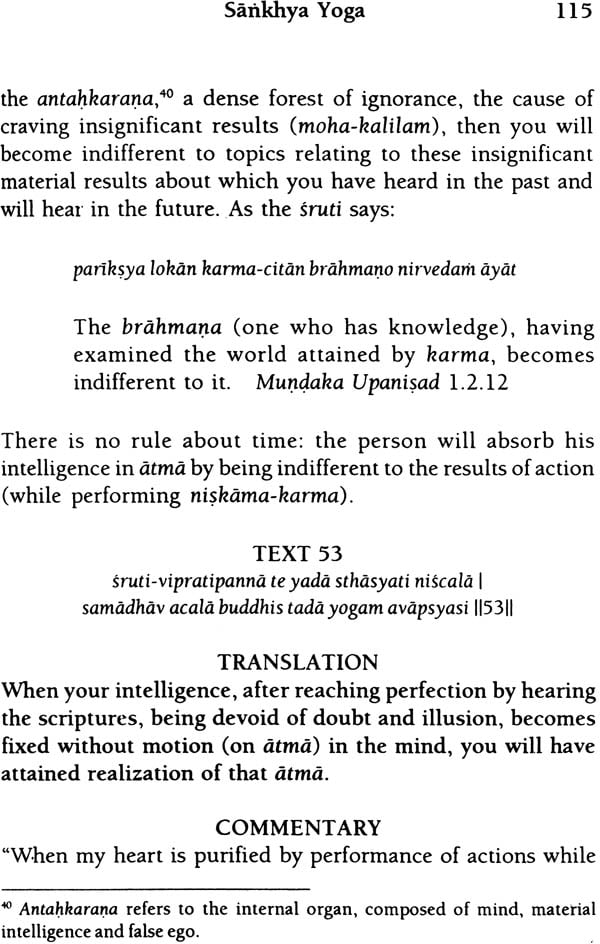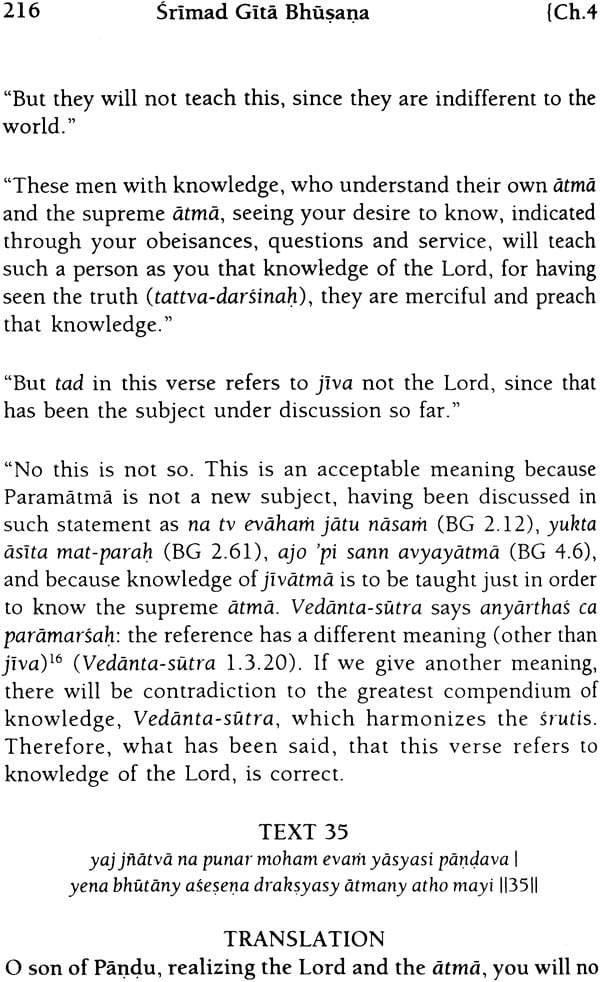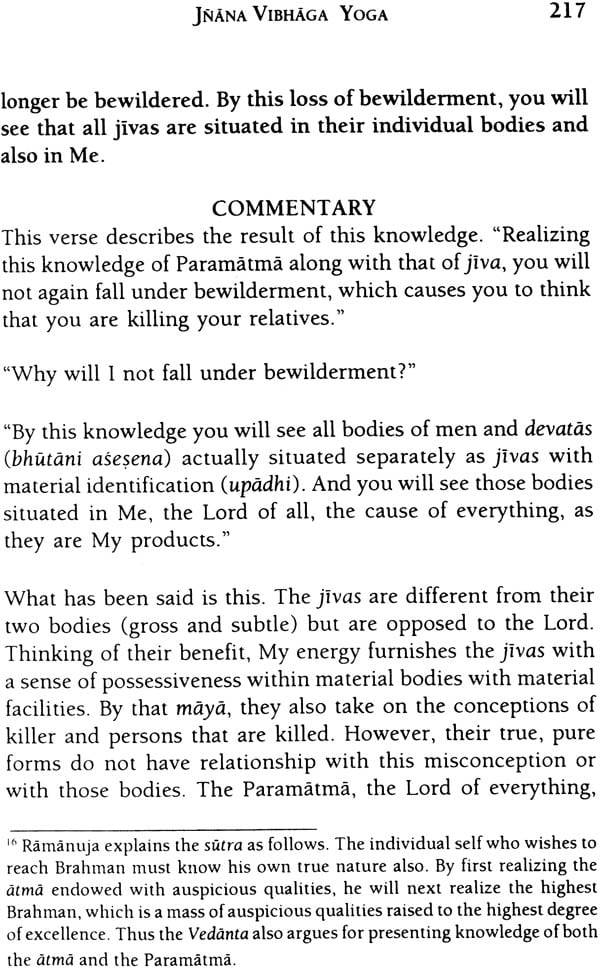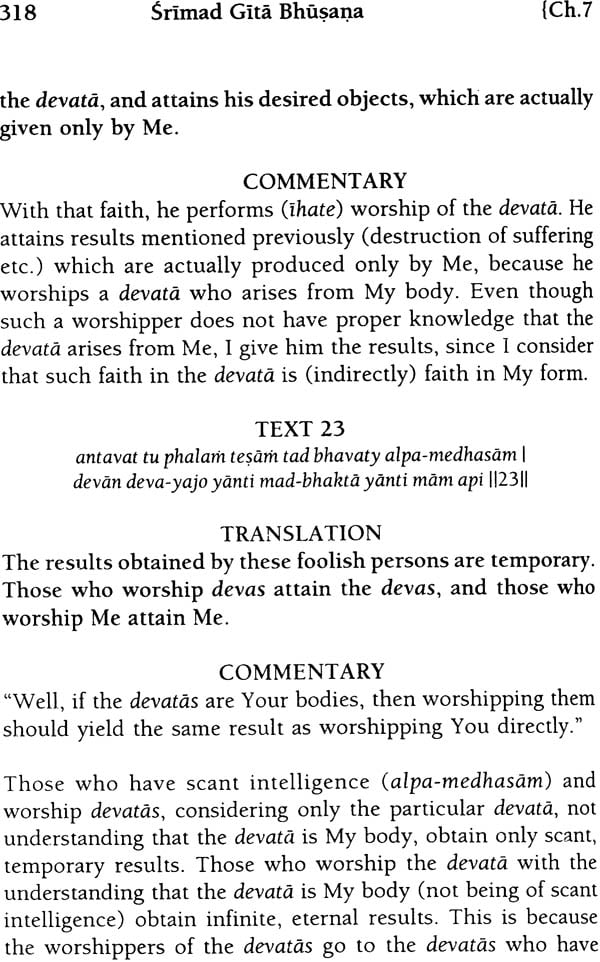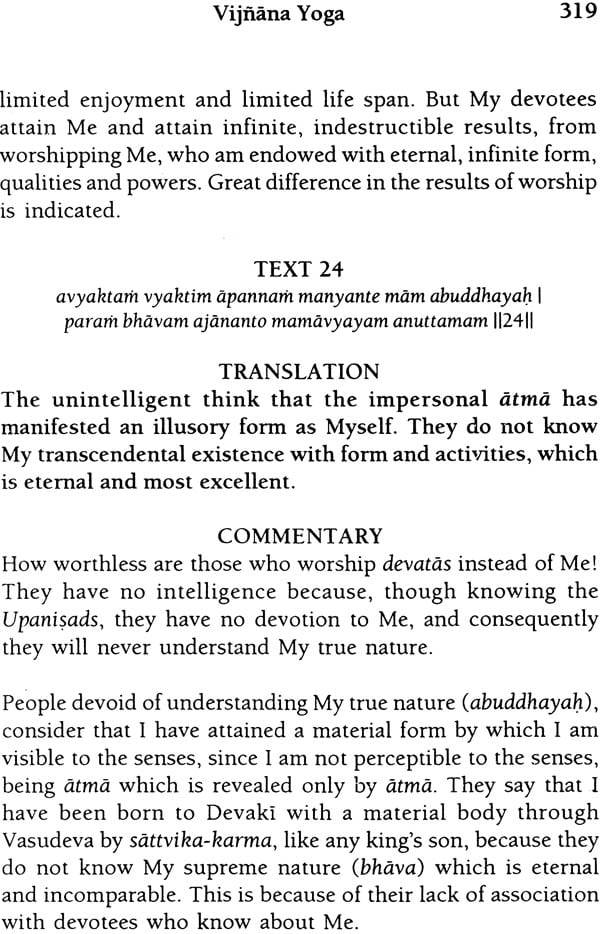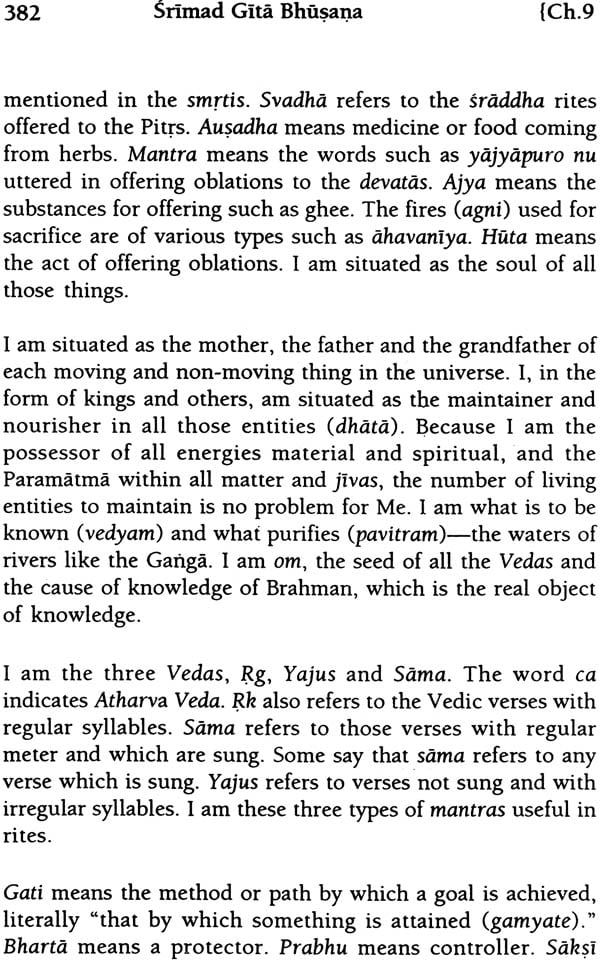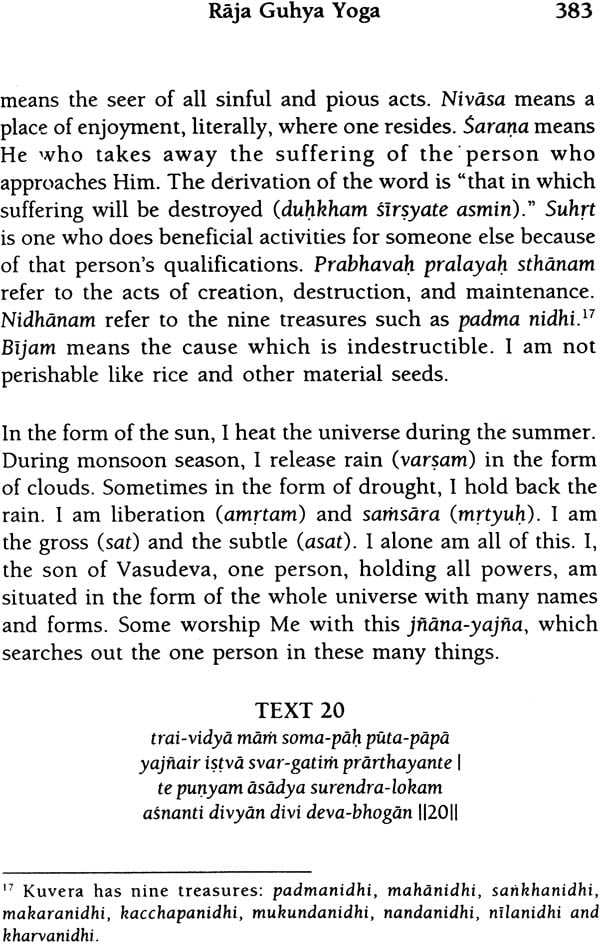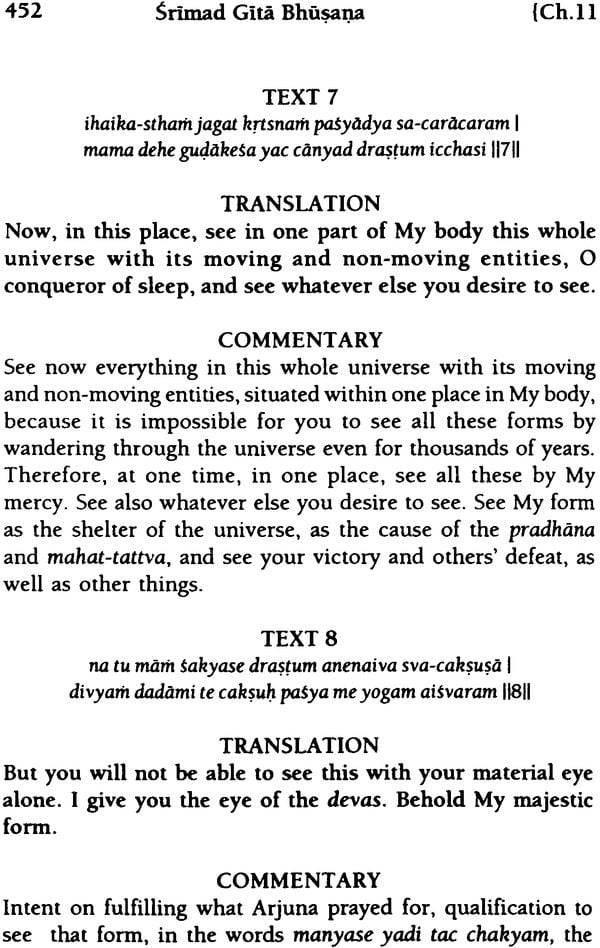
Gita Bhusana: Commentary on the Bhagavad Gita by Baladeva Vidyabhusana
Book Specification
| Item Code: | IDG280 |
| Author: | Srila Baladeva Vidyabhusana Translated into English by His Holiness Bhanu Swami |
| Publisher: | Sampradaya Publishers |
| Language: | English |
| Edition: | 2005 |
| ISBN: | 9788189564070 |
| Pages: | 570 |
| Cover: | Hardcover |
| Other Details | 8"X5.5" |
| Weight | 900 gm |
Book Description
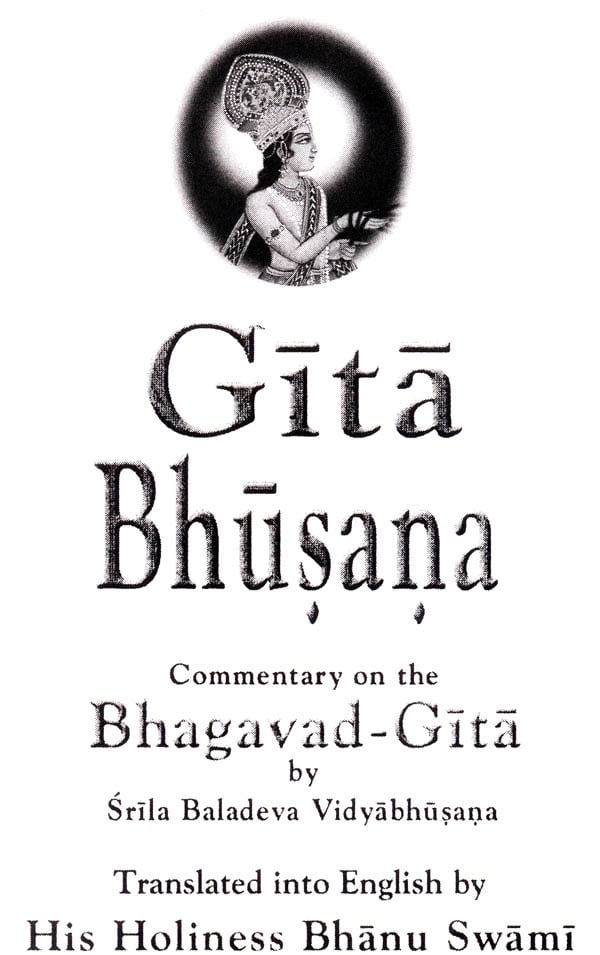
Back of Book:
"With care, Vidyabhusana has attended upon this commentary called Srimad Gita Bhusana. O devotees who are greedy for the sweetness of prema of Sri Govinda and who are filled with mercy, please purify this work." Srila Baladeva Vidyabhusana.
"In Srila Baladeva Vidyabhusana's commentary, we will find the influence of both Ramanujacarya in particular verses and Madhvacarya in the general philosophy. In his refutation of impersonal interpretations of the Gita, he takes some of the arguments from Sri Ramanuj acarya's commentary on the Gita. He takes the concept of visesa, the power by which particulars inhere in an object, from Madhvacarya, in order to explain the non-difference of God from His qualities." Srila Prabhupada Lecture-Seattle, October 18, 1968
Foreword:
One can ask why did Srila Baladeva Vidyabhusana consider it necessary to write a commentary on the Bhagavad-gita, when shortly before that his siksa guru; Srila Visvanatha Cakravarti Thakura, had written an excellent and original commentary perfectly in harmony with Gaudiya philosophy. His personal answer to that question we will never know.
However, by examining his commentary, Gita Bhusana, the reader will be able to appreciate that he has indeed made a significant contribution to the study of the Gita in writing it. Like Srila Visvanatha Cakravarti's, his explanations are unique and consistent with the whole of the Gita, and yet his commentary is quite different from Visvanatha's. At the same time, the explanations are in harmony with the Gaudiya philosophy. Thus, we have two equally brilliant commentaries on the same text. Both conclude the supremacy of Krsna and pure bhakti, but with different explanations of the verses leading to that conclusion. Within one sampradaya, we have two differing explanations of a work, both of which we accept as correct. Inconceivably, the two commentaries are different but harmonious.
In Srila Baladeva Vidyabhusana's commentary, we will find the influence of both Ramanujacarya in particular verses and Madhvacarya in the general philosophy. In his refutation of impersonal interpretations of the Gita, he takes some of the arguments from Sri Ramanuj acarya's commentary on the Gita. He takes the concept of visesa, the power by which particulars inhere in an object, from Madhvacarya, in order to explain the non-difference of God from His qualities
However, we will also find original ideas in his commentary. He presents the concept of three types of devotees: the sanishta, parinisthita and nirapeksa in order to bring unity to the whole of the Gita. The sanistha bhakta follows the gradual process: niskama karma yoga (varnasrama), followed by jnana yoga, astanga yoga, and finally bhakti yoga. Thus all the processes described in the first six chapters can be considered essential for the sanishta bhakta's development. The parinisthita bhakta directly engages in the devotional processes of hearing and chanting as his main sadhana. He also performs varnasrama rules, but without attachment, only to set an example for less advanced persons who do not have strong faith to practice bhakti as their main sadhana. The nirapeksa bhakta performs only bhakti and rejects the rules of varnasrama. He is usually a renounced person. The latter two types of devotees are called ananya bhaktas or pure devotees, though they are practicing sadhana. They are considered superior because of their direct practice of bhakti. These two types are described in the middle six chapters, and at the conclusion of the Gita. This explanation of the relationship of varnasrama to bhakti may be useful to readers for application in their own lives.
In producing commentaries, the authors often resort to explanations of the words of the verse in their grammatical context within the sentence, while at the same time explaining the words' implied meanings in the context of the subject at hand. This often gives rise to long, complex sentences which become difficult to follow in English, but are quite clear in sanskrt. Such sentences have been broken up for easier comprehension, though in the process, the explanation of the grammatical context may disappear. Please bear that in mind while reading. Comments or explanations of the commentary are usually in footnotes. Please forgive any mistakes in translation or interpretation.
I hope the reader will find the commentary stimulating to the intellect and nourishing to the soul, bringing about greater faith and devotion to Lord Krsna.
May my mind remain eternally fixed on SrI Govinda, who is the ultimate perfection of real, infinite, inconceivable powers, and who thus controls everything; who is expert in protecting His devotees; who is also the root of creation, maintenance and destruction of the universe; and who is full of bliss.
I offer my respects to the Gita, which was spoken by the Lord endowed with perfect qualities. It is a work by which the ocean of ignorance meets its complete end,' by which pure bhakti becomes fully nourished to the highest degree, and by which, the supreme truth, normally difficult to understand, becomes eternally manifest.
Svayam Bhagavan Krsna, condensed happiness and knowledge, is the Supreme Person endowed with inconceivable power. His feet are the object of meditation by Brahma and others, who create, maintain and destroy the variegated universe in accordance to His order. Through such pastimes as His birth, He gave exceeding joy to His associates, whom He treated equal to Himself, and who appeared with Him. And by His pastimes He liberated many jivas from the tiger's mouth of ignorance. Wishing to deliver others in the future, after His own disappearance, He placed Arjuna, whom He considers His own Self, under seeming bewilderment at the commencement of the battle by His inconceivable energy. Then, on the pretext of removing Arjuna's ignorance, He spoke to Arjuna His own Gitopanisad, which excellently ascertains the real nature of Himself and His energies.
Five subjects are described in the Gita: Isvara, jiva, prakrti, kala and karma. Among them, the all-powerful conscious being (vibhu-samvit) is the Lord, Isvara. The minute conscious being (anu-samvit) is the jiva. Prakrti is that substance which is the shelter of the three gunas: sattva, rajas and tamas. Kala is unconscious substance (dravya) devoid of the gunas. 2 Karma refers to the force of destiny produced from the actions of men.
The characteristics of these items are as follows. Among them, the first four-Isvara, jiva, prakrti and kala-are eternal. Jiva, prakrti, kala and karma are under the control of isvara. The fifth item, karma, has no beginning (anadi) and is liable to destruction, like prior non-existence (prag-abhava).3 The only objects which have consciousness as their essential property (svarupa) are isvara and jiva. They are aware of other things (samvetta) and have recognition of "I" (self-awareness- asmad-artha).4 The sruti says:
vijnanam anandam brahma
That Brahman is knowledge and bliss. Brhad Aranyaka Upanisad 3.9.28
manta boddha karta vijnanatma purusah
That Lord who is knowledge itself is the controller, the knower, the doer. Prasna Upanisad 4.9
yah sarva-jnah sarva-vit
He knows all things, and knows everything about each thing. Mundaka Upanisad 1.1.9
Also the sruti says (concerning self-awareness):
so 'Kamayata bahu syam
He desired, "May I become many." Taittiriya Upanisad 2.6
sukham aham asvapsam na kincid avedisam
I slept happily and was not aware of anything. 5
This awareness of self in both the Lord and the jiva is not the material ahankara which arises from the mahat-tattva. That is a meaningless proposal, since the material ahankara disappears during pralaya. (so 'kamayata shows that the Lord had an identity before manifestation of ahankara.)
Thus, the Lord is proved to be both a doer and experiencer (karta and bhokta) from the use of the words sarva-jna, servavit, boddha and karta. The equivalence of knowing with experiencing (or enjoying) is recognized by all, as in the following statement.
so 'snute sarvan kaman saha brahmana vipascita
He enjoys all sense objects along with the knowing Brahman. Taittiriya Upanisad 2.1
This statement makes clear the equivalence of the two words "knowing" and "enjoying."
| Page No. | |
| Foreword | i |
| Introduction | 1 |
| Chapter 1 Sainya Darsana The first chapter summarizes the story surrounding the Gita. | 9 |
| Chapter 2 Sankhya Yoga A person will become a jnani, remembering the Lord, by performance of niskama karma. To do otherwise creates only obstacles. This is the essence of the second chapter. | 35 |
| Chapter 3 Karma Yoga The third chapter explains that one should principally practice niskama karma yoga, and secondarily, jnana yoga, which arises from it, for gaining a vision of the atma. | 101 |
| Chapter 4 Jnana Vibhaga Yoga Karma or action has two parts like grain with its husk. As the rice is superior to the husk, jnana is superior to the gross part. That is the conclusion of the fourth chapter. | 139 |
| Chapter 5 Karma Sannyasa Yoga By niskama karma yoga, the most prominent yoga, which has within it jnana, the sanistha attains liberation. This is the meaning of the fifth chapter. | 171 |
| Chapter 6 Dhyana Yoga In the sixth chapter, Mukunda speaks of the illuminating nature, of astanga yoga. | 193 |
| Chapter 7 Vijnana Yoga The devotees of five types know Krsna in truth and they cross over His maya. This has been described in the seventh chapter | 225 |
| Chapter 8 Taraka Brahma Yoga The amsa mixes with yoga, through the path of light, but Krsna Himself is attained only through ananya bhakti. This is explained in the eighth chapter. | 253 |
| Chapter 9 Raja Guhya Yoga In this chapter, bhakti, like the Ganga, not considering who is suitable or unsuitable, and destroying all sins by its very touch, is alone considered to be the king of all secrets. | 279 |
| Chapter 10 Vibhuti Yoga By Krsna's energy alone the universe is maintained, and by a small particle of His energy the sun derives its intense heat, and all other objects possess their powers. This Krsna is worshipped in the tenth chapter | 313 |
| Chapter 11 Visvarupa Darsana Yoga The eleventh chapter shows that Krsna is the complete form of God, because He is the source of all avataras, and He is thus the cause of the victory for His devotees, the sons of Pandu, on the battlefield in Bharata. | 345 |
| Chapter 12 Bhakti Yoga Krsna is controlled by the persons devoted to Him alone, and by the persons devoted solely to the process of bhakti dedicated to Him. The most beautiful Krsna is conquered completely by love. This is explained in the twelfth chapter. | 385 |
| Chapter 13 Prakrti Purusa Vibhaga Yoga Both the jiva and the Lord are situated in the body. The jiva, joined to the qualities of the body, is bound up, but is liberated by understanding the Lord. This is the knowledge of the thirteenth chapter. | 403 |
| Chapter 14 Guna Traya Vibhaga Yoga One remains in samsara by combination with the gunas. One becomes liberated by surpassing the gunas. This is attained only by devotion to the Lord. This is the knowledge to be gained from chapter fourteen. | 437 |
| Chapter 15 Purusottama Yoga From the fifteenth chapter, one learns that the person who is different from the conditioned and liberated souls-and who supports both and is superior to both-is the Supreme Lord Krsna. | 457 |
| Chapter 16 Daivasura Sampad Yoga Those fixed in understanding the meaning of the Vedas achieve Svarga and eternal liberation. Those who reject the Vedas go to hell. This is the conclusion of the sixteenth chapter. | 477 |
| Chapter 17 Sraddha Traya Vibhaga Yoga Rejecting faith arising from one's impressions, the person who takes shelter of faith arising from scripture becomes qualified for the highest goal. This is the ordinance of the seventeenth chapter. | 495 |
| Chapter 18 Moksa Yoga There are many methods, but among them, surrender (prapatti), along with the attitude of being a servant, quickly pleases Visnu. This is the conclusion of the eighteenth chapter. | 513 |
| Acknowledgements | 566 |
| About the Author | 567 |
| Note From the Publisher | 569 |
